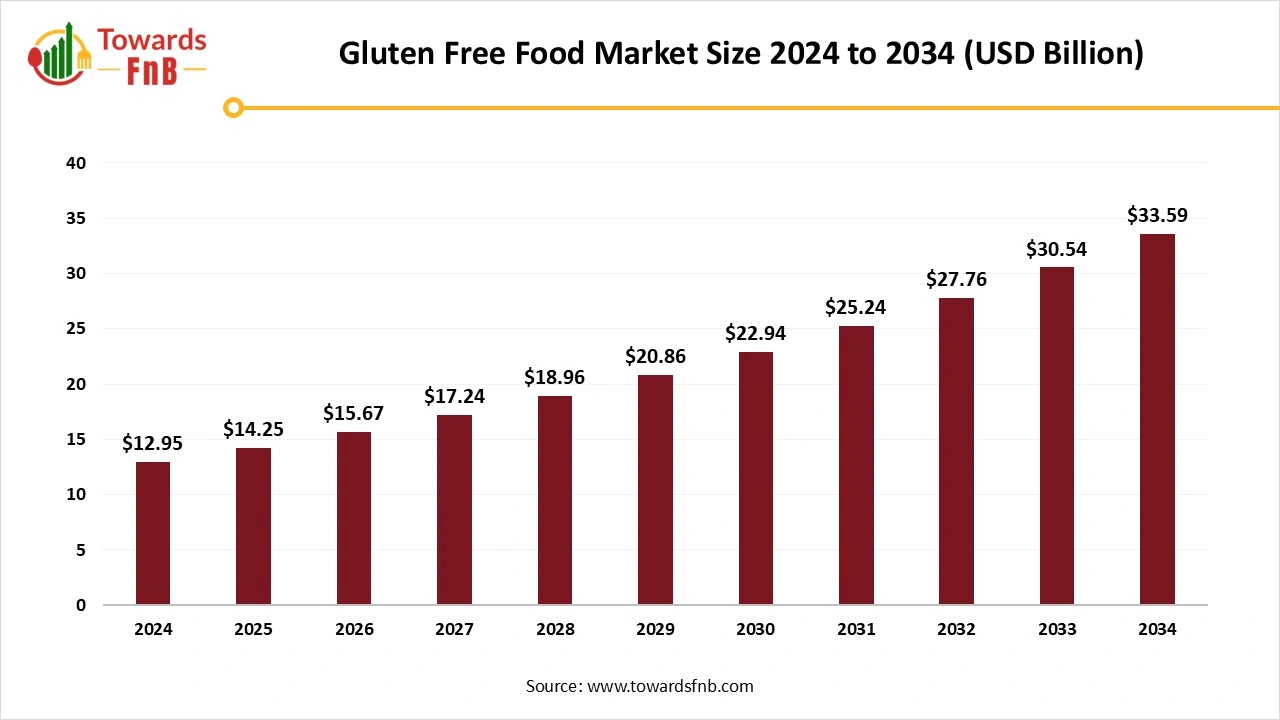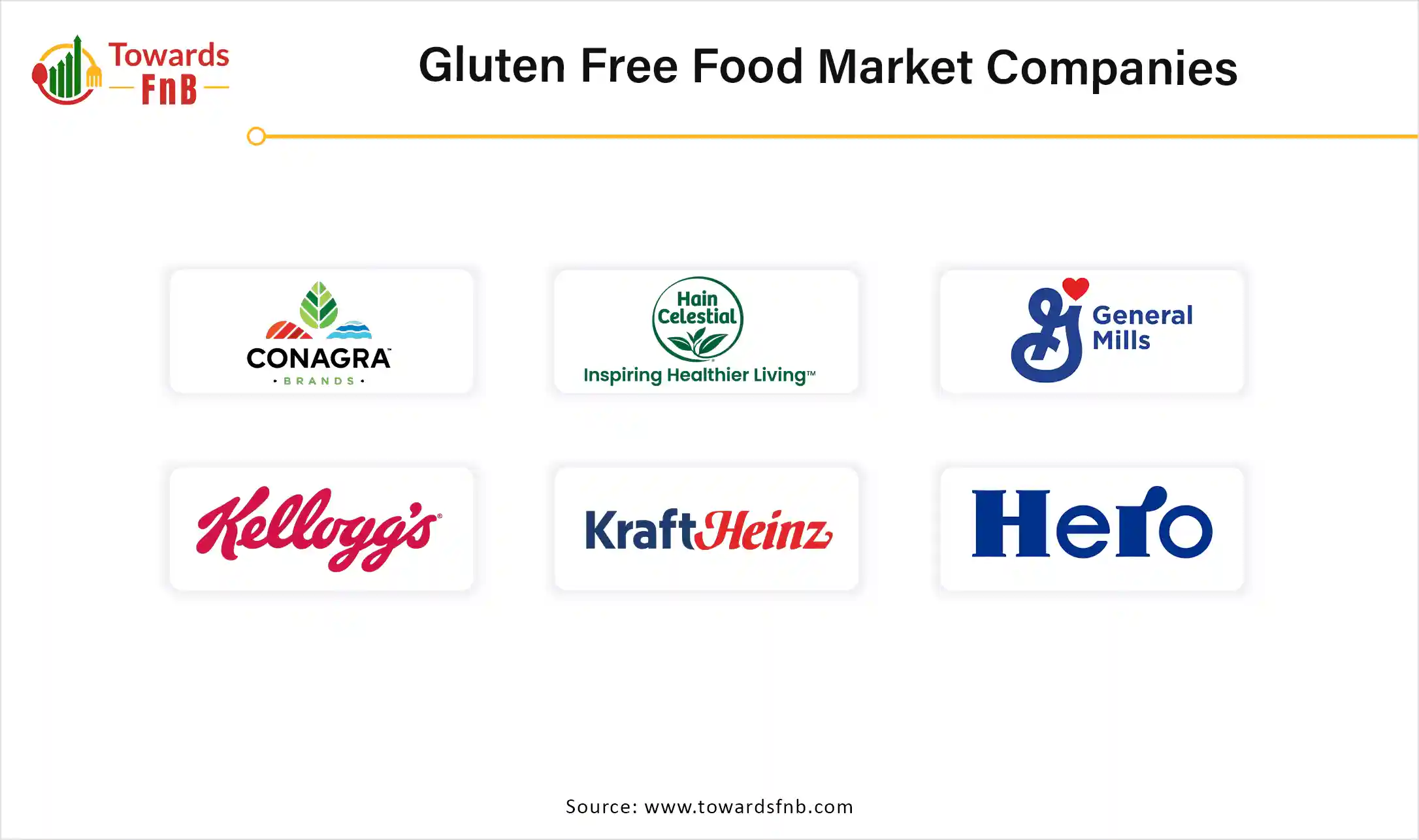December 2025
The global gluten free food market size was calculated at USD 12.95 billion in 2024 and is forecast to rise from USD 14.25 billion in 2025 to approximately USD 33.59 billion by 2034, registering a CAGR of 10% during the forecast period from 2025 to 2034. Increasing prevalence of celiac disease, awareness regarding celiac disease and healthy diet habits are driving the market of gluten free food. The gluten free food market is driven by the increasing prevalence of gluten sensitivity and celiac disease.

| Study Coverage | Details |
| Growth Rate from 2025 to 2034 | CAGR of 10% |
| Market Size in 2025 | USD 14.25 Billion |
| Market Size in 2026 | USD 15.67 Billion |
| Market Size by 2034 | USD 33.59 Billion |
| Largest Market | North America |
| Base Year | 2024 |
| Forecast Period | 2025 to 2034 |
| Regions Covered | North America, Europe, Asia-Pacific, Latin America, and Middle East & Africa |
The global prevalence of celiac disease ranges between 0.7% and 2.9% in the general population. This increasing burden of celiac disease and food allergies demanding for the gluten free food and thus fostering the market. Moreover, the expansion is driven by broadening the product line beyond traditional baked goods to also encompass snacks, ready-to-eat foods, and beverages, highlighting the demand for convenience.
The increase in the proportion of retail trade and online sales has escalated overall market expansion, as gluten-free items are now readily available in supermarkets and online platforms. Furthermore, the incorporation of clean labels and organic trends in product development redirects focus of manufacturers towards natural, protein-packed, and alternative flours like almond, coconut, and quinoa, which has boosted the market.
Micro-encapsulation technology is utilized to enhance the shelf-life and texture of gluten-free baked goods. This technology aids in boosting moisture retention and addressing texture issues. The quality of gluten-free products is maintained through the controlled release of constituents by micro-encapsulation. Methods for microencapsulating substances and their utilization in the food sector is a highly encouraging field that will further expand as the potential growth opportunity in the market.
The growing awareness of celiac disease and gluten intolerance has driven the global gluten-free food market. However, the excessive amount of gluten-free diet for newly diagnosed celiac disease patients is challenging the market growth. Researchers are actively innovating the gluten-free diet and celiac disease, where some studies have found the harmlessness of the gluten-free diet for celiac disease. These innovations are likely to cause social restrictions on the use of gluten-free foods.
Raw Material Procurement
Packaging and Branding
Waste Management and Recycling
North America dominated the gluten free food market. The growth of the market is attributed to the rising awareness regarding the health and increasing adoption of heathy millets, and other gluten free diets in their daily routine is driving the growth of the market. Additionally, the increasing prevalence of the celiac disease in the United States population and increasing number of allergic conditions due to the gluten-based foods and easy accessibility of gluten free products are collectively accelerate the growth of the market.
Which Factors Promote the Gluten-Free Food Industry’s Growth in the U.S.?
The U.S. is a major player in the regional market, contributing to growth due to the country's large gluten intolerance and celiac disease population and growing awareness. The demand for healthier options and ongoing advancements in food technology is forecasting this market. The U.S. has a large health-conscious consumer base, driven by awareness and rising diagnoses of gluten-related disorders, making innovations and the adoption of gluten-free foods.
Asia Pacific is projected to grow in the market during forecast period. The growth of the market is attributed to the growing population and the rising awareness regarding the health and dietary supplements which boosts the demand for the healthy food that boosts the demand for the gluten free food. The rising presence of the people with the celiac disease that boosts the demand for the alternative food options which contributed to the expansion of the gluten free food market.
China is a major player in the regional market, contributing to growth due to the country's increased awareness of gluten-related illnesses in the country. China has a large food consumer base, and the growing foreign food trends and health consciousness are driving demand for gluten-free foods in this population. The expanding e-commerce industry and online strategic business are contributing to this growth. The gluten-free bakery products are the dominant segment in China.
India is a significant player in the regional market, with growth driven by increased awareness of gluten intolerance in the country. The rising health-conscious consumers, especially millennials and Gen Z, are driving demand for gluten-free foods in India. Additionally, the expanding online food service industry and innovative food strategies to attract young and health-conscious consumers are driving the Indian gluten-free food market.
Europe is expected to grow at a notable rate during the forecast period. The market growth in the region is driven by factors such as the increasing consumer trend towards gluten-free diets for health and wellness, increasing prevalence of gluten-intolerance and celiac disease. Germany, France, and UK are the major countries driving the market growth in the region.
Germany Gluten Free Food Market Trends
The global market in Germany is driven by increasing demand for specialized organic stores and supermarket chains, increasing consumer trend towards healthier diets, and increasing awareness of gluten sensitivity and celiac disease.
Why is Middle east and Africa Revolutionizing the Gluten Free Food Market?
The market growth in the region is driven by factors such as the increasing availability via online and modern retail channels, increasing prevalence of gluten sensitivity and celiac disease, increasing health awareness, increasing prevalence of gluten-free diseases, improved availability and increasing need to educate both the food service industry and consumers about gluten-free options.
UAE Gluten Free Food Market Trends
The market growth in the country is driven by rising product innovation, increasing prevalence of gluten intolerance and celiac disease, and increasing consumer awareness towards health and wellness. Major drivers such as an increasing number of online stores and regional manufacturers and increasing demand for healthier options.
What Factors Help Latin America Grow in 2024?
Latin America gluten free food market is driven by the increasing availability of gluten-free options in restaurants and retail, increasing consumer shift towards healthier lifestyles and increasing awareness of gluten sensitivities and celiac diseases.
Brazil Gluten Free Food Market Trends
The gluten free food industry in Brazil is witnessing major growth, driven by increasing focus on health and wellness, increasing rates of gluten intolerance and celiac disease and increasing demand for gluten-free products such as gluten-free baked goods, snacks and pasta.
The Bakery Product Segment Led the Gluten Free Food Market in the Gluten Free Food Products.
The rising consciousness regarding healthy diets, including natural, organic, and gluten-free products, is expected to propel the expansion of this segment. Whereas gluten-free snacks and ready-to-eat foods segment is projected to grow throughout the forecast period. Different innovative, smart and attractive foods by industries are launched and demand is increasing due to busy lifestyle and requirement of healthy nutrition rising the market.
The Hypermarkets and Supermarkets Segment Dominated the Gluten Free Food Market in 2024.
This segment offers convenient access to various items in one place, making it simple for shoppers to select products from numerous choices. Seasonal displays, featuring gluten-free items, contribute to the introduction of new products and ultimately enhance segment growth. Furthermore, online segment is anticipated to grow with highest CAGR in forecast period. The online platform offers several advantages that are especially attractive to millennials and younger individuals, including the ease of shopping from home, home delivery, complimentary shipping, and special discounts.

By Product
By Distribution Channel
By Region
December 2025
December 2025
December 2025
November 2025